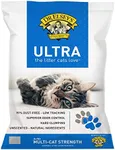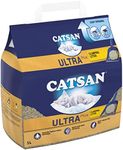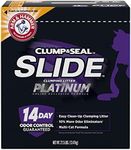Buying Guide for the Best Cat Litter Cats
Choosing the right cat litter is essential for both your cat's comfort and your convenience. The right litter can help control odors, reduce mess, and make cleaning easier. When selecting cat litter, consider your cat's preferences, any allergies or sensitivities, and the litter box setup you have. It's also important to think about how much time you want to spend on maintenance and cleaning. Understanding the different types of cat litter and their features will help you make an informed decision that suits both you and your feline friend.Material TypeCat litter comes in various materials such as clay, silica gel, recycled paper, and natural/biodegradable options like corn or wheat. The material affects absorbency, odor control, and dust levels. Clay is popular for its clumping ability and odor control, but it can be dusty. Silica gel is low-dust and long-lasting but may not be preferred by all cats. Natural options are eco-friendly and often less dusty, but they may not clump as well. Consider your cat's preferences and any allergies when choosing a material.
Clumping vs. Non-ClumpingClumping litter forms solid clumps when wet, making it easier to scoop out waste and keep the litter box clean. Non-clumping litter absorbs moisture but doesn't form clumps, which means the entire box may need to be changed more frequently. Clumping litter is convenient for daily maintenance, while non-clumping might be suitable for those who prefer less frequent cleaning. If you want easy daily cleaning, go for clumping; if you prefer a simpler setup, non-clumping might be the way to go.
Odor ControlOdor control is crucial for maintaining a pleasant environment. Some litters have added fragrances or baking soda to help mask odors, while others rely on natural odor-absorbing properties. If you or your cat are sensitive to scents, opt for unscented litter. For households with multiple cats or strong odors, a litter with strong odor control features might be necessary. Consider how much odor control you need based on the number of cats and the litter box location.
Dust LevelsDust levels in cat litter can affect both your cat's respiratory health and the cleanliness of your home. High-dust litters can cause respiratory issues for sensitive cats and leave a mess around the litter box area. Low-dust or dust-free options are better for minimizing these issues. If your cat or anyone in your household has respiratory sensitivities, prioritize low-dust litter to ensure a healthier environment.
TrackingTracking refers to how much litter gets stuck to your cat's paws and is carried outside the litter box. Some litters are designed to minimize tracking, keeping your floors cleaner. If you find litter scattered around your home, look for a low-tracking formula. Consider the texture and weight of the litter, as heavier and larger granules tend to track less. If keeping your home clean is a priority, choose a litter with low tracking properties.
AbsorbencyAbsorbency is the litter's ability to soak up moisture, which affects odor control and cleanliness. Highly absorbent litters help keep the litter box dry and reduce odors. Clumping litters are generally more absorbent, making them a good choice for effective moisture control. If you want a litter that keeps the box dry and odor-free, focus on options with high absorbency.

















